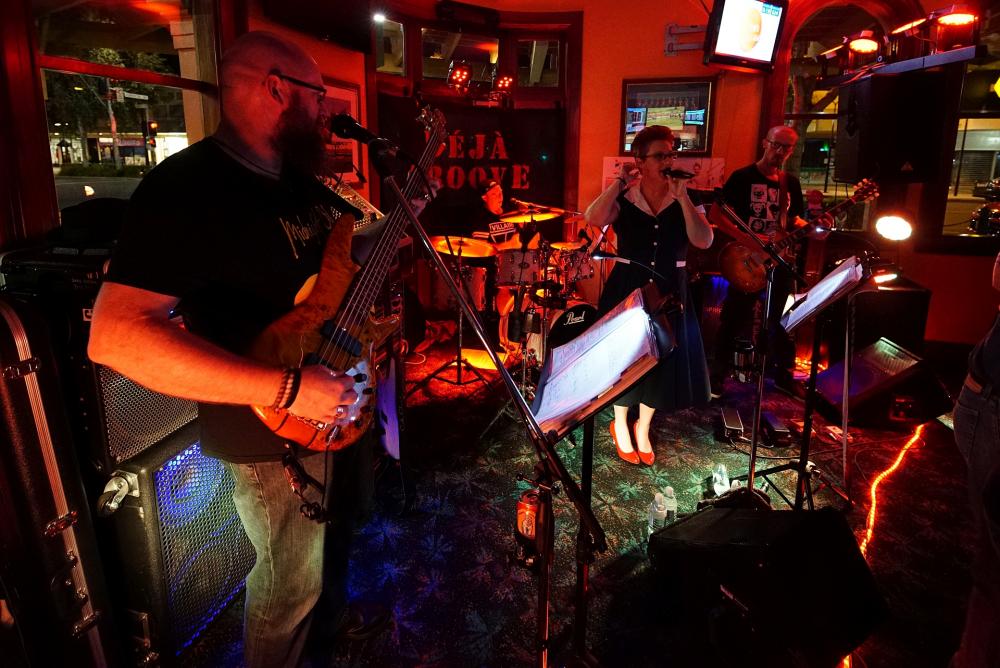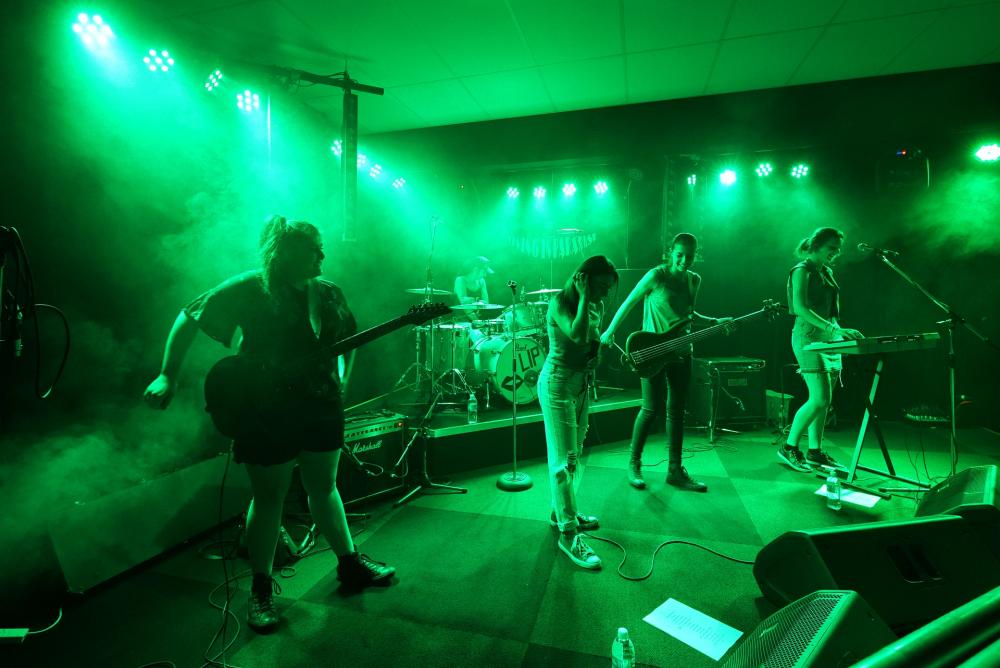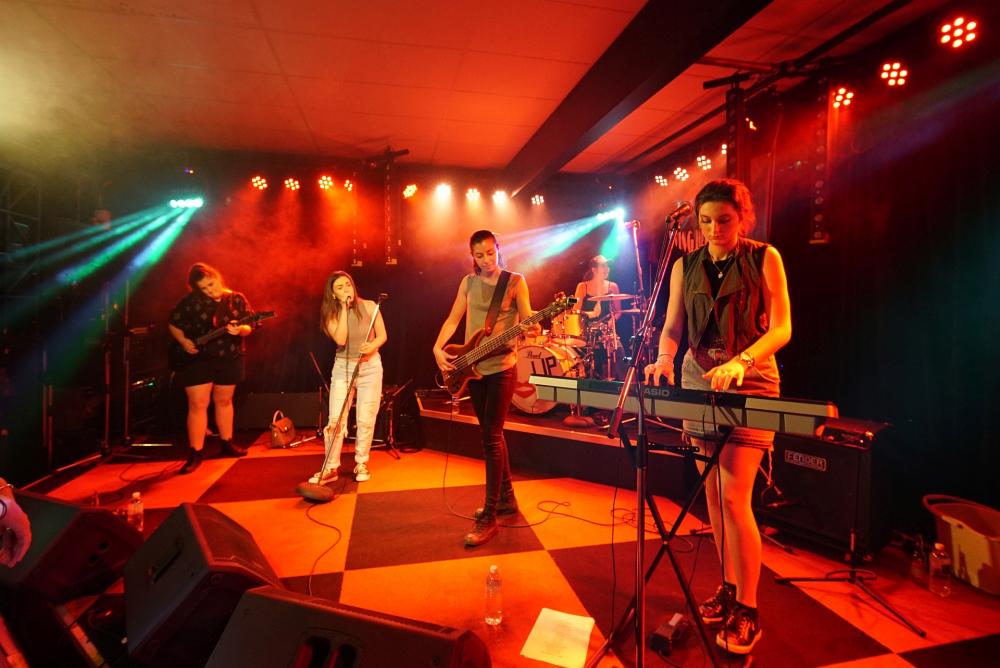-
Posts
1,623 -
Joined
-
Last visited
Content Type
Profiles
Forums
Articles
Everything posted by noone
-
What I found interesting in that opening post link is that someone actually used the BM pocket cinema camera for a cinema film.
-
I still love the first A7s as it fits my needs better than any camera to date. I prefer the size shape of the first over the second A7# cameras. I would think the biggest change to an A7siii would be something like 18 or 20mp as well as 4k 60p. Better AF with adapted lenses would be nice but Sony isn't likely to aim for that. Batteries are not that much of an issue to me. Easy enough and small enough to carry what you need and If you use them fresh, you can get a lot more out of them than if you leave them in the camera and shoot sparingly.
-
I can't remember so maybe I was there! Actually I am not THAT old so it might have been Railroad Gin in the early 70s as a teenager. Literally hundreds since then though and everything from Metal to Jazz.
-
Looks good. Just bear in mind that the manufacturers ISO settings against what DXO measures is significantly lower than most (almost all) cameras. IE D500 manufacturers ISO 100 setting measures at ISO 75 while E-M1 ii ISO 200 measures at ISO 83. If you look at the SNR 18% chart on DXO, the lines for the two cameras run very close together but if you look at the numbers, the ISOs adjacent are a stop apart so for example, if you look at the settings that give you around 24db, while the lines are together, the Nikon is getting 24.6db at ISO 6400 on the camera (measuring at ISO 4705) while the Oly is getting 23.9db at ISO 12800 but it is measuring at only ISO 5505. Just about all cameras measure low but this is below just about everything (except maybe the GH4 at ISO 25600). https://www.dxomark.com/Cameras/Compare/Side-by-side/Olympus-OM-D-E-M1-Mark-II-versus-Nikon-D500-versus-Panasonic-Lumix-DMC-GH4___1136_1061_943 While there is nothing wrong with that, I don't think it is entirely apples to apples.
-
I used to shoot in grainy black and white as well as grainy colour film. The main reason for black and white for me was it was better to look at than colour gave. Even now with digital, you will see people convert shots to B&W if they are above what you would normally expect from a camera. Of course, sometimes it is a valid choice on its merits too. Again, I am not saying don't light. I am simply saying if you want or need to add light, do it but equally since photography IS about and needs light, then available light (even if very dim) is also a valid choice. I just picked up my old Pentax Spotmatic. The highest film speed I can set is 1600 and the fastest shutter speed is 1/1000 (actually mine says 1/500 but Pentax was too cheap to use different shutters and on my lower model they didn't mark the 1/1000 setting but it is still there). I would push film a bit sometimes but the grain could be huge. Likewise my old Nikon D50, highest ISO I can set is ISO 1600. My Pentax IST*D was (I thought then) ok at ISO 3200 and the same with other cameras. A Pentax Kx I would use almost to ISO 12800 but really 6400 was about it. I didn't like my Canon 7D over ISO 3200. As each generation gets better, it just means I can use faster shutter speed longer or higher ISOs or slower lenses or stop down lenses more. In a few years, people will be using phones better in low light than an A7s or any current camera. Progress is nice. There would have been very few combinations that you could use to get a shot of a full rock band from next to the stage with film. It is just fun for me and the bands seem to like what I do.
-
Whatever!!!!! Look, that stage IS brilliant, the bands love it but it is not MY venue. I am shooting available light there just as at every venue. Even at that venue, I can be shooting at extreme ISOs as the lighting varies so use auto ISO and flash would not work for me and neither would video lights when I have shot video there (same lenses, same ISOs).. Many cameras would be fine there and I would have loved using my previous gear there and I would have said exactly the same thing (IE disagreeing with anyone saying "Whoever believes that a camera that shoots in high iso saves them a proper lighting setup and/or a crew, haven't really understand what is going on. Photography, is "writing of light", not the lack of it."). I shot/shoot at many venues and none are anywhere near as well lit as that. The top shot was ISO 3200, the second at ISO 4000. On the way home I stopped in briefly at another venue and shot This is still an ok venue for lights so I was still able to be at ISO 12800 for this. If I wanted to use f8, I would have been at ISO 25600 or at other venues still I would have been higher. I take what comes. So tell me, what would YOU do? Use flash? Take video lights to a pub? Or would you use available light in those situations within the limits of whatever gear was available to you?
-
-
I didn't see anyone saying that lights don't have a place (and a pretty big place) in many situations. I did see someone saying "Whoever believes that a camera that shoots in high iso saves them a proper lighting setup and/or a crew, haven't really understand what is going on. Photography, is "writing of light", not the lack of it." So when you shot live events you ONLY used lights/flash? I have used many cameras for live music for years back to film SLRs and I have always hated using flash on the band. I am fine with using flash to shoot the people who come up to me for their photo at these gigs. Flash/video lights kill the stage light/atmosphere and sometimes, it used to be that the lighting was simply too low for my gear. Now it isn't regardless of how low the light. A7s just means I can shoot at lower light levels. As for IBIS, though I love it (have had five cameras with it), I don't think it has ever been of use for live music for me and neither has IS/OSS/VR. There is a big place for lights/flash and there is a big place for not using it too for me anyway. But I am not lighting it and that same stage varies greatly from very very bright walls of light to extremely dark. My ISOs vary from one extreme to the other in an instant there. It is the best stage I know for bands.
-
Excuse me band, excuse me pub, excuse me patrons but would you mind if I used video lights throughout your song? From time to time someone does bring in a video camera/camcorder with light and it is REALLY annoying (just like using flash every shot). Some venues have great stage lighting too and that is what I would prefer. My ISOs can range from something like ISO 400 to 80,000 with variable stage lighting so it isn't just high ISO. Living in Paradise
-

Opinion - DXOMark's camera scoring makes ZERO sense!
noone replied to Andrew - EOSHD's topic in Cameras
But it doesn't measure lower for noise! They have almost the exact same measurements for noise at the same manufacturers settings. Yes, the settings vary slightly from each other to what they actually measured (as opposed to what the camera says it is) but that might be down to sample variation. It seems that for video, the A7sii may well be around stop better from the comparisons around but remember, they are testing RAW stills. What reason would they have to lie? The cameras use the same sensor and the results seem to indicate that. -
If it was purely film VS digital, for my uses it would be digital every time. Low light/live music and I never want to use film again for stills and while I never shot a band video with film, I never want to either. I just use video as shot for limited use (mainly at 25p at 1/50 on a tripod/table with auto ISO) so mine IS likely what many would describe as "video" but when I am often at ISO 25600/51200 and even higher sometimes that's ok by me.
-
I had no issues (GX7 camera and 45 1.8, 12 f2 and 14-42 ii kit lens). I found the Pana 20 to be ok for AF, just it could not be used for AFC for stills.
-
FF equivalency is sometimes useful if you have a FF camera and other formats as well. Even for video (at least it is for me). Geez my A7s has both APSC and FF video and my GX7 is M4/3 and I often use the same lenses on all of them BECAUSE they are different and it means I don't have to buy more lenses than I already have. Yes a 27mm lens IS a 27mm lens no matter what the format but the angle of view isn't the same. Didn't Fincher use other formats besides S35? So you think he would have used the 27mm equally on S16? Dead horse flogged once more just in case it was just playing dead!
-

Opinion - DXOMark's camera scoring makes ZERO sense!
noone replied to Andrew - EOSHD's topic in Cameras
They down rated Canon because the cameras didn't have the highest DR at base ISO. They can not give a camera a higher rating than they can measure. Once you got to higher ISOs, those Canon cameras would often be as good (if not better) which is why you don't just go off the headline figure. The latest Canon cameras are as good as the competition at base ISO now so they get higher scores for example, they measured the 5Diii at 11.7 stops of DR but the 5Div gets 13.6 stops (nearly 2 full stops). At higher ISOs the improvement is less than a stop. That plus the other improvements is why the 5Div gets a much higher score. Many of the situations where a much lesser camera gets a higher score, that is what they measure but if you look further, you will find the lesser cameras fall away much quicker. Sometimes the lesser cameras have higher pixel counts too. With Nikon for instance, if you want 24mp and only shoot with top class manual focus lenses like an Otus at base ISO, you may well be better off with a D5## than getting a better more expensive camera. Besides DXO, Bill Claff has a pretty good site for sensors. http://photonstophotos.net/ His chart (not all cameras are there). http://www.photonstophotos.net/Charts/PDR.htm -

Opinion - DXOMark's camera scoring makes ZERO sense!
noone replied to Andrew - EOSHD's topic in Cameras
DXO has their explanations. https://www.dxomark.com/About/Sensor-scores/Overall-Score https://www.dxomark.com/About/Sensor-scores/Use-Case-Scores Low light score in particular is an actual ISO and I think the easiest to explain. "Sports & action photography: Low-Light ISO Unlike the two previous scenarios in which light is either generous (studio) or stability is assured (landscape), photojournalists and action photographers often struggle with low available light and high motion. Achieving usable image quality is often difficult when pushing ISO. When shooting a moving scene such as a sports event, action photographers’ primary objective is to freeze the motion, giving priority to short exposure time. To compensate for the lack of exposure, they have to increase the ISO setting, which means the SNR will decrease. How far can they go while keeping decent quality? Our low-light ISO metric will tell them. The SNR indicates how much noise is present in an image compared to the actual information (signal). The higher the SNR value, the better the image looks, because details aren't drowned by noise. SNR strength is given in dB, which is a logarithmic scale: an increase of 6 dB corresponds to doubling the SNR, which equates to half the noise for the same signal. An SNR value of 30dB means excellent image quality. Thus low-light ISO is the highest ISO setting for a camera that allows it to achieve an SNR of 30dB while keeping a good dynamic range of 9 EVs and a color depth of 18bits. A difference in low-light ISO of 25% represents 1/3 EV and is only slightly noticeable. As cameras improve, low-light ISO will continuously increase, making this scale open." It has nothing to do with AF etc so I think the sports scores are pretty reasonable maybe more so if you just consider them as low light rather than sports and remember it is based on their criteria. I am fine with using an A7s for night time sports. I use an old manual focus 300 2.8 anyway so it just means I can use a higher shutter speed. None of the shots would be printed huge so 12mp is fine. A modern FF DSLR would be a better sports CAMERA most of the time but does it have a better sports SENSOR (given DXOmarks criteria)? The overall scores are a bit based on voodoo as the bits that go into that are subjective without full explanation as to weighting. I think some of the anomalies might be because of a low number of samples tested given many cameras get slightly different scores with the same sensors. A slight difference might be just enough to take a camera a bit over or a bit under their marks. I don't think the A7s is any noisier than the A7sii and It seems the colour depth might be why the A7sii gets a lower score for low light (the point they cross 18 bits for colour sensitivity). For video it is all a bit silly though as they are only testing RAW stills and most video is Jpeg. I would love to see a site test sensors for video. RAW and otherwise. -
Well, it seems you can buy the sensor now in the Weapon 8k. Cost $49,000 for the brain (EDIT $29,500 with a lesser brain). Add a basic recommended package $5,643 (and you still can not just shoot). That will take 2 to 3 weeks to ship from Red. http://www.red.com/store/products/weapon-brain-with-helium-8k-s35-sensor Those Japanese cameras will cost less than the BASIC package needed to be able to use it and you can walk into a shop in many places and buy one. Many of the mass produced things are being made by people working for an awful lot less than if they were made in the US (or almost any western country). I can see a point where there wont be any workers in factories (or very few) and at that point you might start seeing production coming back to Western countries as costs will be the same. We might be there already for some things but not yet for mainstream cameras. THIS, is not a mainstream camera and I doubt there would be a huge number of employees in the RED factory/factories. I hope that cameras ARE made in the west and soon though as long as I can get what I want and can afford (this isn't either- way beyond me) I don't care where it is made really.
-
Three YEARS? What do you think Sony, Canon and others who make sensors will have by then? Sony should be at the A7Riv and A7siii or iv by then! Actually, my guess is A7Riii with the iv just announced and people whinging about their A7Riii being discontinued so quickly. A7s iii will be popular and the iv will come a bit later in the year. A9 will still be coming soon! Then again, my crystal ball is a bit cracked and is a first version Sony anyway.
-
Fuji something recent and not entry level? That is just a guess from your profile (a stills camera). It seems to have some shallow depth at times so it does seem like APSC too. With at least in part a 23 1.4? (many Fuji lenses have 9 blades and some have 7 and this had 7 at least part of the time). Just guessing. Could be a phone to for all I know but it seems ok and put together well..
-
While I HOPE you are right, what I heard just before about the Russians having a fat file on Trump makes me wonder. It doesn't help when what he says one day is so often different at a later date and he denies saying/doing what is (usually) shown alongside his denials. Putin seems to say whatever he wants as well but with more authority behind him. I was thinking they would just do what they could to enrich themselves and divide up the world. Hopefully there are plenty of checks and balances still against them (or anyone).
-
Is DT a wholly owned subsidiary of Vladimir Putin INC?
-
It should if it is a Canon mount lens and you use either a Metabones smart adapter (focal reducer or non focal reducer) or Kipon (non focal reducer only). That is it should at least work for AF for stills. Video will need someone to try the lens with the various adapters.
-
f we're talking video, it's important that the user uses a camera with a workflow suited to the user, not according to camera specs. In this case it sounds like the user is not too well versed with color correcting / grading, and hence Nikon/Canon which are known for having good colors straight out of the camera should be a great alternative. Rather than having to work with LUTs and colour grading in post for a good result which the Sonys have been known for. Maybe the modern A6300 and A6500 are better and have suitable colour profiles that this specific user would be happy with, maybe not. They won't be the same out of the box as what the user is used to at least." Let's make another point here.. at this price range, Sony gives you the ability of slog , canon and nikon will not... You can use picture profiles in the a6300 as well of course and Andrew's PP are quite good but she is going to very tempted to play around with colouring /slight grading and you can do that efficiently either shooting with a log or a toned down, flat profile.. Resolve is very capable in its free edition and has very nice colour tools. Since his mum is a an accomplished photographer and knows her way around handling photo raw's she will certainly be able to handle some wb corrections and some basic colouring at leat. It is of course her preference to do this or shoot to a picture profile but the capability is there.. Sony handles colours differently than Canonikon but at least in raw photographs you can get the warm Canon look if you want . Jpeg's not so. I have not been unhappy with the colour from any maker really (Canon, Nikon, Pentax, Sony, Panasonic, Olympus used in interchangeable lens digital cameras). I like Sony jpegs though that is subjective and many will prefer others. While I like Sony colour as it seems closer to reality to me often, for those that don't want to grade with Sony E mount, there is also the Liveview grading App (costs $10) and it gives millions of different combinations to play around with. I had it with my A7 and even that was far more than I need for video. You could spend years trying out all the combinations available. "This app expands creative possibilities by letting you fine-tune the color of your movies while viewing the effects in real-time. What used to require special equipment or software can now be done with just your camera! You can adjust color depth, color saturation and other parameters manually or apply one of several presets — such as Clear, Vivid, Monochrome or Bold — to produce popular tonal effects with ease." https://www.playmemoriescameraapps.com/portal/usbdetail.php?eid=IS9104-NPIA09014_00-000010
-
I don't know how well they would work with an A6300 for eye AF but even the cheap (sub $100) Fotga adapter works for eye AF with my A7s and Canon lenses. I don't use it a lot even with native lenses as it only works in AFS on the first gen A7# cameras. Eye AF is not usable for me with the A7s with Canon lenses (slow AF anyway and only in AFS means it only works on posters/photos or extremely still people). I think most adapters would work with it on a later model camera like the A6300 (there are a lot of different adapters).
-
I don't know what you should take, I just wanna see the results!
-
If the shooting is under ISO 800 I would agree. I just have a feeling that ISOs would rise quickly in the evening in a place like Patagonia and the A7s just in terms of DR for RAW stills doesn't drop away as quickly as the Nikon and Sony APSC cameras. The 6D is another that I would prefer in a place like that over the smaller sensor cameras. D810 would be by far the best for daytime stills but would be too heavy for me (by limiting other things) and it also drops away as the ISO rises. It just means you can shoot for longer with a camera like the A7s depending what your DR requirements are. Really even the 6D with 11 stops at ISO 100 is good enough for day time use I would think. I think it matters more if a camera holds its DR longer (unless ONLY shooting at base or near base ISO).





